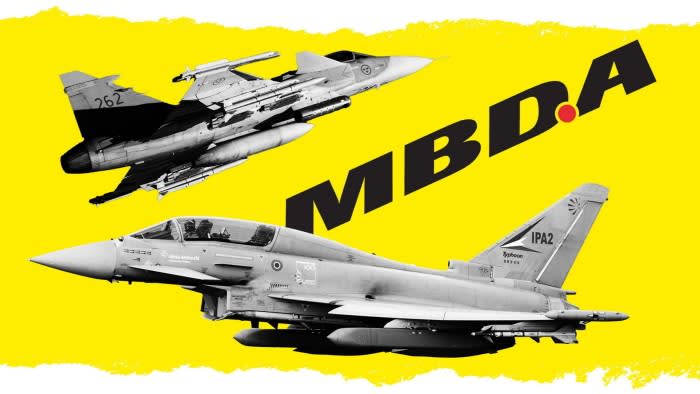When the British military needed new cruise missiles in the mid-1990s, the government passed over established US weapons makers in favour of a nascent company with little record.
The lucrative order for the air-launched missile called Storm Shadow, and its French version Scalp, was key to cementing a groundbreaking marriage between the UK and France formed by the merger of British Aerospace’s missile manufacturing division and France’s Matra.
“The company only came to life once there was a big new programme from the French and British armies,” said Fabrice Brégier, who led the group 1998 to 2003.
Today Storm Shadow/Scalp has become one of Ukraine’s most potent weapons in its fight against Russia, and the company behind it has since developed into MBDA, a European missile powerhouse able to compete with America’s Lockheed Martin and Raytheon.
“There was a political and industrial recognition that the European industrial base was too fragmented . . . It was a case of needs must. You either survive together or sink independently,” said Douglas Barrie, senior fellow at the International Institute for Strategic Studies.
MBDA’s successful cross-border manufacturing and one-company ethos is today being held up as a model for the type of defence industry collaboration needed for Europe, which is grappling to bolster the output of its military contractors in the face of the war in Ukraine.

All too often conflicts over jobs, workshare and a potential loss of sovereignty have stymied closer co-operation. Progress on Europe’s two flagship defence programmes, to build a next generation fighter jet and a future tank project, has been held up by infighting among contractors and discord among countries.
Other industrial co-operations have worked. Airbus, similarly created as a response to US might, has been a standout as a maker of commercial aircraft, with record orders last year and aircraft deliveries totalling 735, almost 40 per cent higher than US rival Boeing. But on the defence side, some of its activities have been less successful; its pan-European A400M military aircraft programme was plagued by delays.
Pooling resources may be the only way forward if EU countries’ armed forces are to improve their equipment and develop new costly projects while overcoming fragmentation and overlap in the industrial base. If Donald Trump is re-elected as US president, Europe may have to fend more for itself on defence.
“The future will tend towards the MBDA model,” said Sebastian Lecornu, the French defence minister, at a recent press conference.
“States agree on their needs as customers and entrust companies whose shareholding is mixed with the task of fulfilling the order . . . [The approach] is very respectful of sovereignty since it allows both for economies of scale and for each state to remain in control of its own needs.”
After British Aerospace and France’s Matra merged their missile activities in 1996, MBDA was formally created five years later following the inclusion of Italian defence assets via Alenia Marconi Systems. The company is owned by BAE Systems and Airbus, which hold 37.5 per cent respectively, with the balance held by Leonardo of Italy.

Industry executives familiar with MBDA’s formation said there was a recognition among all stakeholders that it was important to create a pan-European company with a single management, but one which had a national identity in each of its countries.
MBDA, said Francis Tusa, an analyst and editor of the Defence Analysis newsletter, “is standout, the one European company that works”. “Compared with anyone else, they have got rid of nationalism.”
Company structure and governance were crafted to foster a pan-European culture, yet one that can also serve national armies and protect national security interests. Each country has a subsidiary with separate accounts and management, and confidential projects can be siloed off to only involve nationals of a single country.
For example, the Taurus, a cruise missile system with superior capabilities to Storm Shadow/Scalp, is made by a joint venture between MBDA Deutschland and Sweden’s Saab.
Overall, the top jobs are parcelled out to achieve a balance by nationality, with the British holding three, the French three, the Italians two and Germany one. The chair is always from BAE Systems and the chief executive is always French.
Even so, Marwan Lahoud, chief executive of MBDA in the mid-2000s, said the head had to be “above the melee”.
“I was not the French executive defending the interests of MBDA France,” he told the Financial Times. “I had to be British in the UK, French in France, German in Germany and Italian in Italy. If you want to integrate a team, you need to overcome your national interests and act in the interests of the whole.”

While tensions over where to put factories or research centres did crop up, executives said what allowed MBDA to overcome them was the fact that it was up to management to decide, not governments.
The Eurofighter consortium of Airbus, BAE and Leonardo, which builds the Typhoon combat jets for Britain, Italy, Spain and Germany, also operates successful cross-border manufacturing. But its management has not held full authority, according to analysts.
Eurofighter Jagdflugzeug, the company that co-ordinates the programme on the industrial side, “might have been a company in name — but it couldn’t really operate as one with managerial authority — this rested with each of the partner nations at the domestic level,” said Barrie at IISS. By contrast, “MBDA senior management has authority”.
At times, MBDA executives have also helped to convince national armies to pool their resources, such as when they persuaded Italy and the UK to collaborate on a new generation of air defence missiles rather than develop separate ones.
The absence of direct state involvement has also helped MBDA.
“States are bad shareholders because their missions as shareholders, regulators, customers and guardians of national security create permanent conflicts of interest,” said Lahoud.
Industrial integration has also played a key role. Éric Béranger, MBDA chief executive, said the “more you are industrially integrated, the more you are able to offer the possibility to nations to co-operate on given programmes, there is some sort of virtuous circle on this”.
The group’s next generation air-to-air defence missile Meteor, was developed by a six-nation European partnership. Its integrated workshare across the six nations — including MBDA’s five partner nations, the UK, France, Italy, Germany and Spain — is illustrative of the company’s integrated manufacturing.
The backbone of MBDA’s model remains the original Franco-British alliance, underpinned by the Lancaster House Treaties of 2010. A big part of the reason for the company’s success was the creation of specialised centres of excellence between the two nations as part of an agreement in 2015.
Under the agreement, each country took the lead on a range of missile capabilities, in effect ceding certain industrial expertise to the other. This principle of “mutual dependence” allowed the group to cut duplication and costs. The Franco-British agreement also allowed Britain the right to export missiles carrying French components without constraint and vice versa.
MBDA has not been immune to problems. Like other European companies, it has struggled to ramp up production, notably of its Aster missile that has been in demand in Ukraine and recently for French naval patrols of the Red Sea.
As the French army waits for an order placed last year for 200 Asters at a cost of €900mn, defence minister Lecornu has dialled up the pressure on MBDA, reminding it he could requisition factories or order it to prioritise the French contract. “MBDA owes us rapid deliveries,” he recently warned.
Some industry stakeholders argue there could be wider co-ordination across MBDA. “We don’t have an array of European missiles — countries have, for the most part, not bought each others’ weapons,” said a former UK defence official.
Collaboration on missile manufacturing, added the official, was also easier than on large projects for tanks and jets, for example. “It is easier to do at this scale. The nations have not had to pool their sovereignty as they would have had to do if it was for large programmes.”

Nevertheless, Ukraine has underlined that more needs to be done. There is “still too much fragmentation”, said Barrie. “You need political will, you need programmes and you need industrial willingness and a recognition that you have to do something.”
Other more recent attempts at cross-border collaboration, notably the Franco-German future fighter project led by Airbus and Dassault Aviation, have been driven by politics.
Progress has been made on a next generation tank between the two nations. Paris and Berlin last month announced a “breakthrough” in talks on the Main Ground Combat System which will succeed the two nations’ existing separate systems: Germany’s Leopard and France’s Leclerc. An agreement on dividing production evenly between German and French companies was finally reached.
National divisions continue to dominate elsewhere. A German-led initiative, European Sky Shield, enraged French officials who saw it as ill-conceived since it omitted European-made air defence systems, including the Franco-Italian made SAMP/T from MBDA, in favour of US/Israeli technology.
Roberto Cingolani, chief executive of Leonardo, said it was important to build critical mass in Europe, even if it meant ceding a little sovereignty.
“This transition is not at all trivial. It is one of the most complex ones that continent-wise you can think of . . . If this were easy it would have been done already.”
Also Read More: World News | Entertainment News | Celebrity News








